Since the deployment of these anti-missile systems, the losses of armor have decreased substantially. It is worth to take a look at this device whose development dates back to 2012.
"First of all I want to thank the SMC team who to took a high risk to share this interesting story with the world "so they know the size of effort done by the tank crews who gave detailed reports to the Syrian Intelligence ,the intelligence agents and assets who tackled death for this project and the engineers and workers of the Syrian Scientific Research Center; and of course the Syrian High Command who entrusted the domestic manufacturing abilities, instructed and provided all necessities for such achievement."
In 2012 militants in Syria started using Guided Anti Tank missiles such as 9M113 Konkurs and 9K115-2 Metis-M that were stolen from Syrian Arab Army's points. The limited number of such ATGMs did not cause a significant problem for the Syrian Arab Armed Forces back then, as the Syrian Forces were able to overcome the limited casualties dealt by these ATGMs.
That situation gradually shifted when militants were supplied by their backers in the United States, Turkey, and Gulf States with more ATGMs such as more 9M113 Konkurs, HJ-8 (Red Arrow), and BGM-71 TOW; the delivery of these ATGMs by large numbers was significant enough to cause a major shift on the battlefield, and perhaps the most significant shift was when the Syrian Arab Army withdrew from the city of Idlib in 2015 after militants used these ATGMs to destroy ~40 SAA heavy
armor.
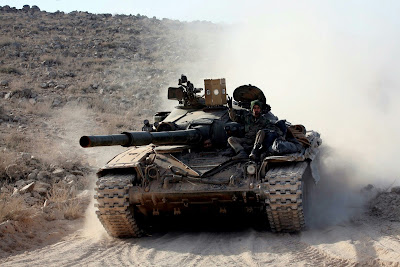
After the Syrian withdrawal from Idlib, the Syrian Military Intelligence studied the aspects of the battles and came up with a full comprehensive report that was submitted to the Syrian High Command; with the ultimate suggestion that the threat of ATGMs must be addressed and eliminated.
The Syrian Command addressed the situation by discussing the available options, which were buying modern armors and protection systems from the Russian Federation and Eastern European Nations.
Around the same time, the Syrian Scientific Research Center (SSRC) provided and alternative solution, a jamming device against all SACLOS Guided ATGMs which was working on since early 2012.
The Syrian Command chose to back up the option provided by the Syrian Scientific Research Center for multiple reasons, the economic one, the time required to bring new armor, and the fact that any domestic solution will mean less dependence on foreign options. Thus, the Syrian Command instructed all Syrian Intelligence Agencies to provide all required data and aid the the SSRC.
To start more specific and valid solution, the first step was to familiarize the SSRC more with what it is encountering; and when it comes to BGM-71 TOW the very first time it was encountered was in 1973 war then in Lebanon 1982 war, and finally the Iranian variant of the Missile "Toophan" . However, the SSRC had to have number of samples of the BGM-71 TOW already being used by militants.
The first BGM-71 TOW captured by SAA was in 2014 in a joint operation with Hezbollah which included three missiles and one launcher . Where the Syrian Intelligence Agencies were able to provide number of different variants of the missile using many methods; the simplest was to buy the missiles from militants where the Syrian Military intelligence were able to buy 18 missiles and three launchers from one FSA formation in the South. Where a SyAAF Intelligence asset among Ahrar Al Sham was able to steal two missiles and two launchers in Idlib from Squr Al Ghab group, and another SyAAF Intelligence asset who was in fact a commander of a group in the South –FSA Tribal forces- provided another two missiles and one launcher. All that was around the same time the Russian Air Forces was deployed in Syria in late 2015.
After SSRC was provided with all what it needs, they were able to initiate the latest active testing phase of the system they had constructed. The system's method was very simple,, the new system generates and mimic the IR signal on the back of the missiles which provide false targeting information to the SACLOS Guided ATGM launch base, and thus the launchers will give false correction information to the ATGM itself and end up losing and missing its target.
The very first prototype of Mirage (Arabic: Sarab) was placed on a T-62 Tank –SSRC tank of choice for testing any system - for battlefield testing; and given the economic factor, and the need to have a system that can be produced with large quantities, and fitted on many different types of vehicles, the initial prototype had a rugged initial design, with a plan for a future upgrade into a complete
protection suite.

The first battlefield testing took place in Khanaser district in the Southern Countryside of Aleppo where the system had it's first successes against ISIS-Launched 9M113 Konkurs ATGMs
Then the tank was dispatched to Latakia's Countryside for more battlefield tests, and there it had it encountered its first BGM-71 TOW where it successfully jammed a BGM-71 TOW. Based on the results from these two battlefield trials the system was adopted by the Syrian Ministry of Defense.
As soon as the first rugged jamming device was adopted, the SSRC initiated its large-scale
production and started working on its upgrades simultaneously.


The first variant Mirage-1 (Sarab-1) had over 80% effectiveness against all SACLOS ATGMs, it utilizes either a classical IR emitters or LEDs depending the production model, can work for 6 straight hours and can be easily mounted on all vehicles as well as stationary checkpoints and defensive points.


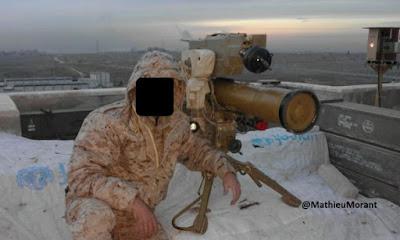
The effects of the Mirage-1 (Sarab-1) system were especially seen on the fronts of the Southwestern Countryside of Aleppo, where SAA armor losses witnessed a significant decrease, and militants began using BGM-71 TOW ATGMs on other non-armored targets such as buildings and barricades in an attempt to score hits after failing hit SAA armor.
Although the first variant Mirage-1 (Sarab-1) had a huge battle success, it had number of drawbacks, the system required a large source of energy and when wired to the vehicles electrical system it shortened the lifespan of the batteries, and it was not as resilient to environmental factors as planned,
and thus it was replaced by a newer more durable variant known as Mirage-2 (Sarab-2).

The Mirage-2 (Sarab-2) System utilized new emitters and fitted new more powerful batteries as an
energy source which increased its operation time to 10 hours before requiring a recharge, and was fitted in a more durable external container which completely surrounded the system for more protection;
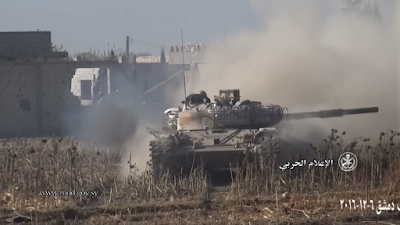
and as far as battle effectiveness, the system had a major success in the operations to liberate Aleppo in 2016 where militants were firing BGM-71 TOW ATGMs almost exclusively against infantry and fortifications where the use of ATGMs against SAA armor was very limited
since they were unable to score any hits

After the Syrian Scientific Research Center addressed all the design issues in Mirage-1 by providing Mirage-2, it switched its efforts to developing a complete soft-kill, or passive-countermeasure system. rather than only a jamming system, and these are the latest pictures of the Mirage-3 (Sarab-3)
on a T-62 used for testes as we said .
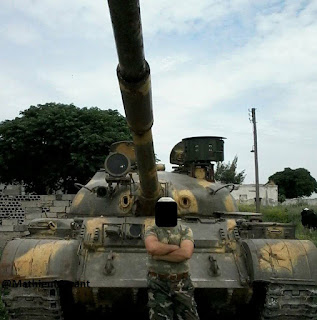
Here we see another set of lenses which could be a different type of emitters or LASER illumination sensors for incoming ATGMs. Also the new Mirage-3 (Sarab-3) Cover 360 degrees where the older models covered only ~180 degrees
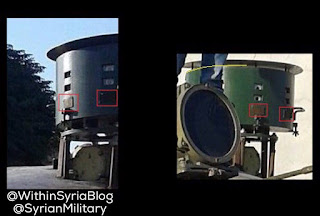
.
Regardless of what experts think of these systems, the only solid fact that is non-deniable is that SAA's heavy and light armor losses were significantly decreased after adopting these systems into service."
Within Syria : Sarab 1 ,2 &3 APS
"First of all I want to thank the SMC team who to took a high risk to share this interesting story with the world "so they know the size of effort done by the tank crews who gave detailed reports to the Syrian Intelligence ,the intelligence agents and assets who tackled death for this project and the engineers and workers of the Syrian Scientific Research Center; and of course the Syrian High Command who entrusted the domestic manufacturing abilities, instructed and provided all necessities for such achievement."
In 2012 militants in Syria started using Guided Anti Tank missiles such as 9M113 Konkurs and 9K115-2 Metis-M that were stolen from Syrian Arab Army's points. The limited number of such ATGMs did not cause a significant problem for the Syrian Arab Armed Forces back then, as the Syrian Forces were able to overcome the limited casualties dealt by these ATGMs.
That situation gradually shifted when militants were supplied by their backers in the United States, Turkey, and Gulf States with more ATGMs such as more 9M113 Konkurs, HJ-8 (Red Arrow), and BGM-71 TOW; the delivery of these ATGMs by large numbers was significant enough to cause a major shift on the battlefield, and perhaps the most significant shift was when the Syrian Arab Army withdrew from the city of Idlib in 2015 after militants used these ATGMs to destroy ~40 SAA heavy
armor.

After the Syrian withdrawal from Idlib, the Syrian Military Intelligence studied the aspects of the battles and came up with a full comprehensive report that was submitted to the Syrian High Command; with the ultimate suggestion that the threat of ATGMs must be addressed and eliminated.
The Syrian Command addressed the situation by discussing the available options, which were buying modern armors and protection systems from the Russian Federation and Eastern European Nations.
Around the same time, the Syrian Scientific Research Center (SSRC) provided and alternative solution, a jamming device against all SACLOS Guided ATGMs which was working on since early 2012.
The Syrian Command chose to back up the option provided by the Syrian Scientific Research Center for multiple reasons, the economic one, the time required to bring new armor, and the fact that any domestic solution will mean less dependence on foreign options. Thus, the Syrian Command instructed all Syrian Intelligence Agencies to provide all required data and aid the the SSRC.
To start more specific and valid solution, the first step was to familiarize the SSRC more with what it is encountering; and when it comes to BGM-71 TOW the very first time it was encountered was in 1973 war then in Lebanon 1982 war, and finally the Iranian variant of the Missile "Toophan" . However, the SSRC had to have number of samples of the BGM-71 TOW already being used by militants.
The first BGM-71 TOW captured by SAA was in 2014 in a joint operation with Hezbollah which included three missiles and one launcher . Where the Syrian Intelligence Agencies were able to provide number of different variants of the missile using many methods; the simplest was to buy the missiles from militants where the Syrian Military intelligence were able to buy 18 missiles and three launchers from one FSA formation in the South. Where a SyAAF Intelligence asset among Ahrar Al Sham was able to steal two missiles and two launchers in Idlib from Squr Al Ghab group, and another SyAAF Intelligence asset who was in fact a commander of a group in the South –FSA Tribal forces- provided another two missiles and one launcher. All that was around the same time the Russian Air Forces was deployed in Syria in late 2015.
After SSRC was provided with all what it needs, they were able to initiate the latest active testing phase of the system they had constructed. The system's method was very simple,, the new system generates and mimic the IR signal on the back of the missiles which provide false targeting information to the SACLOS Guided ATGM launch base, and thus the launchers will give false correction information to the ATGM itself and end up losing and missing its target.
The very first prototype of Mirage (Arabic: Sarab) was placed on a T-62 Tank –SSRC tank of choice for testing any system - for battlefield testing; and given the economic factor, and the need to have a system that can be produced with large quantities, and fitted on many different types of vehicles, the initial prototype had a rugged initial design, with a plan for a future upgrade into a complete
protection suite.

The first battlefield testing took place in Khanaser district in the Southern Countryside of Aleppo where the system had it's first successes against ISIS-Launched 9M113 Konkurs ATGMs
Then the tank was dispatched to Latakia's Countryside for more battlefield tests, and there it had it encountered its first BGM-71 TOW where it successfully jammed a BGM-71 TOW. Based on the results from these two battlefield trials the system was adopted by the Syrian Ministry of Defense.
As soon as the first rugged jamming device was adopted, the SSRC initiated its large-scale
production and started working on its upgrades simultaneously.


The first variant Mirage-1 (Sarab-1) had over 80% effectiveness against all SACLOS ATGMs, it utilizes either a classical IR emitters or LEDs depending the production model, can work for 6 straight hours and can be easily mounted on all vehicles as well as stationary checkpoints and defensive points.



The effects of the Mirage-1 (Sarab-1) system were especially seen on the fronts of the Southwestern Countryside of Aleppo, where SAA armor losses witnessed a significant decrease, and militants began using BGM-71 TOW ATGMs on other non-armored targets such as buildings and barricades in an attempt to score hits after failing hit SAA armor.
Although the first variant Mirage-1 (Sarab-1) had a huge battle success, it had number of drawbacks, the system required a large source of energy and when wired to the vehicles electrical system it shortened the lifespan of the batteries, and it was not as resilient to environmental factors as planned,
and thus it was replaced by a newer more durable variant known as Mirage-2 (Sarab-2).

The Mirage-2 (Sarab-2) System utilized new emitters and fitted new more powerful batteries as an
energy source which increased its operation time to 10 hours before requiring a recharge, and was fitted in a more durable external container which completely surrounded the system for more protection;

and as far as battle effectiveness, the system had a major success in the operations to liberate Aleppo in 2016 where militants were firing BGM-71 TOW ATGMs almost exclusively against infantry and fortifications where the use of ATGMs against SAA armor was very limited
since they were unable to score any hits
After the Syrian Scientific Research Center addressed all the design issues in Mirage-1 by providing Mirage-2, it switched its efforts to developing a complete soft-kill, or passive-countermeasure system. rather than only a jamming system, and these are the latest pictures of the Mirage-3 (Sarab-3)
on a T-62 used for testes as we said .

Here we see another set of lenses which could be a different type of emitters or LASER illumination sensors for incoming ATGMs. Also the new Mirage-3 (Sarab-3) Cover 360 degrees where the older models covered only ~180 degrees

.
Regardless of what experts think of these systems, the only solid fact that is non-deniable is that SAA's heavy and light armor losses were significantly decreased after adopting these systems into service."
Within Syria : Sarab 1 ,2 &3 APS


